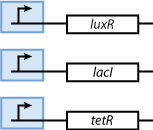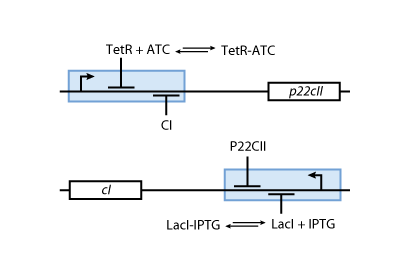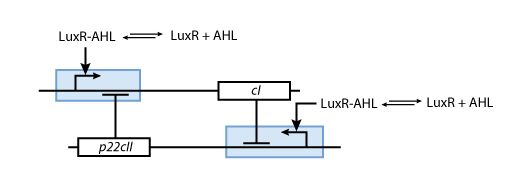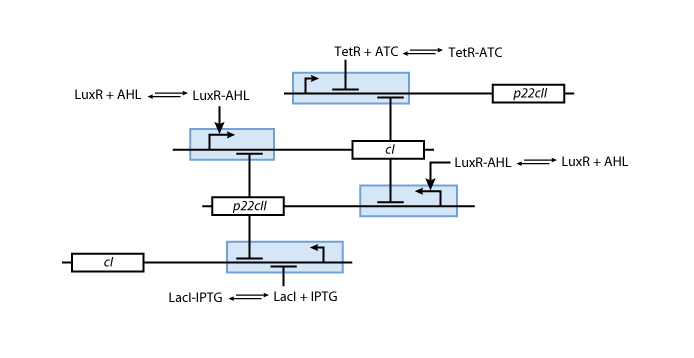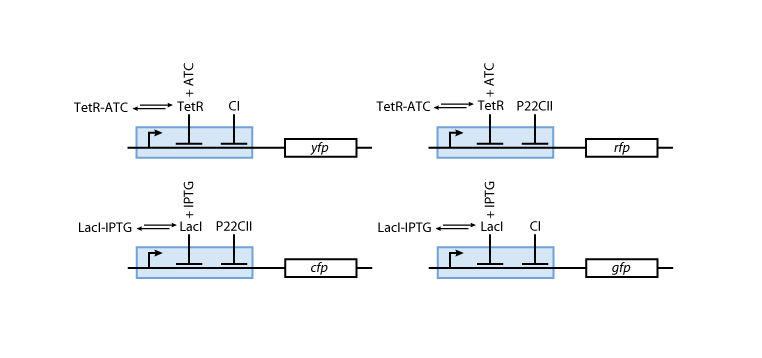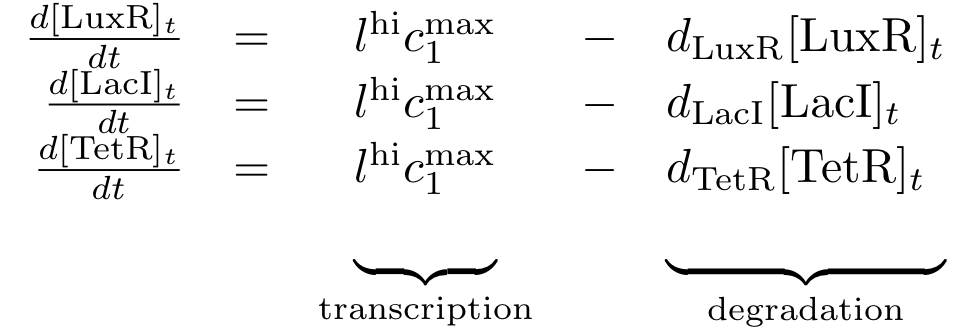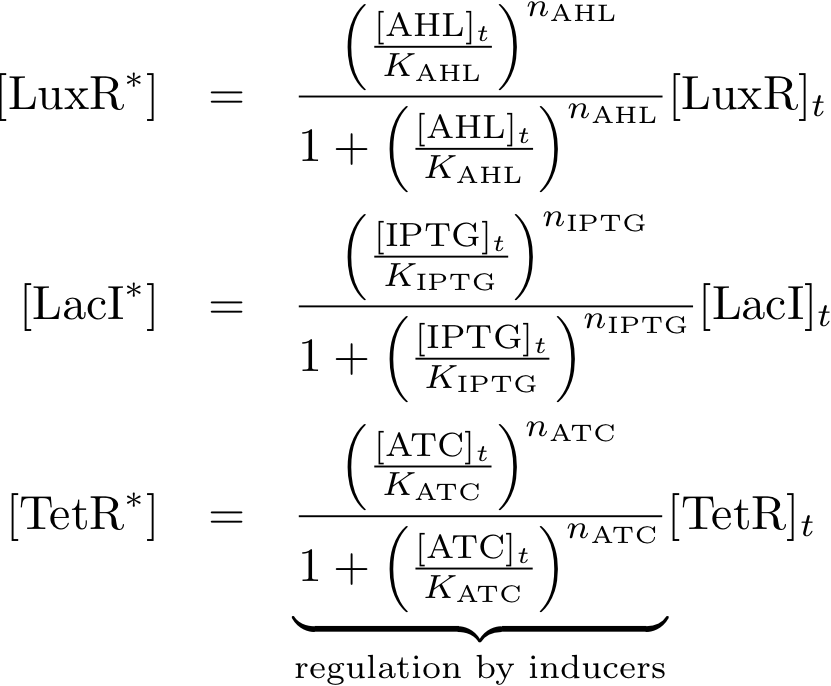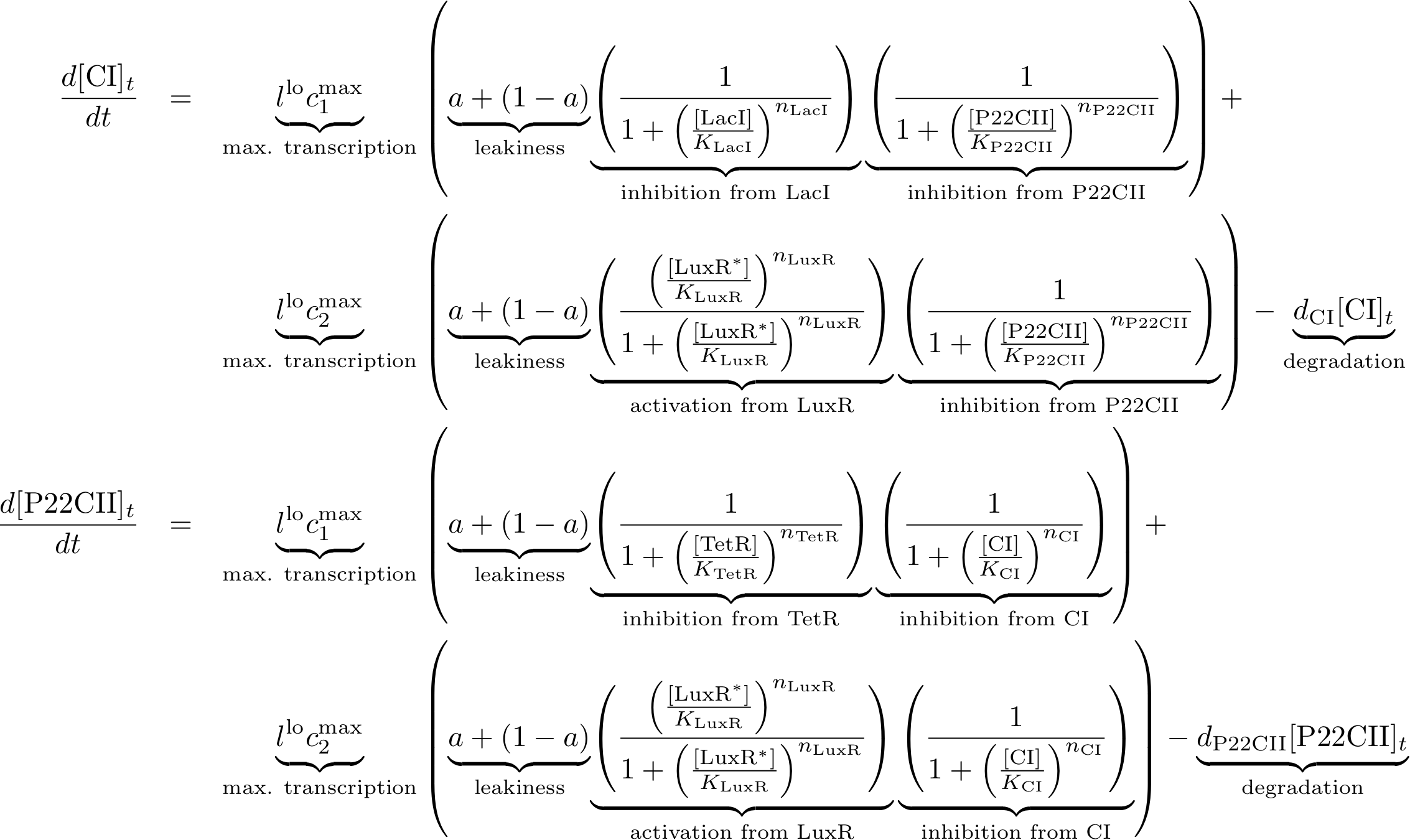ETHZ/Model
From 2007.igem.org
(→Memory) |
(→.:: Modeling the educatETH <i>E. coli</i> System ::.) |
||
| Line 9: | Line 9: | ||
As it has been already discussed in the main page, we are interested in designing a system that is able to adapt to its environment. Our ideas were based on discussions about neural networks, and on how we can create a biological system that exhibits the behavior of learning, without having to resort to evolutionary processes. | As it has been already discussed in the main page, we are interested in designing a system that is able to adapt to its environment. Our ideas were based on discussions about neural networks, and on how we can create a biological system that exhibits the behavior of learning, without having to resort to evolutionary processes. | ||
| - | [[Image: | + | [[Image:ETHz_Flowdiagram.png|thumb|Fig. 1: Flow diagram. This figure shows the protocol with which the final system should be tested as well as the test results in form of the reported colors. There are tree phases the systems has to perform: (1) a training or learning phase in which the system learns an input and stores it in its memory, (2) a memory phase in which the system has to keep the content of its memory and finally (3) a recognition phase where the output of the system depends on the content of its memory as well as on the current input.|450px]] |
Learning can be considered as a switching of behavior, based on some external stimuli. It comes thus naturally, to work on existing ideas of toggle switches and finite state automatons. | Learning can be considered as a switching of behavior, based on some external stimuli. It comes thus naturally, to work on existing ideas of toggle switches and finite state automatons. | ||
Revision as of 12:32, 18 October 2007

.:: Modeling the educatETH E. coli System ::.
As it has been already discussed in the main page, we are interested in designing a system that is able to adapt to its environment. Our ideas were based on discussions about neural networks, and on how we can create a biological system that exhibits the behavior of learning, without having to resort to evolutionary processes.
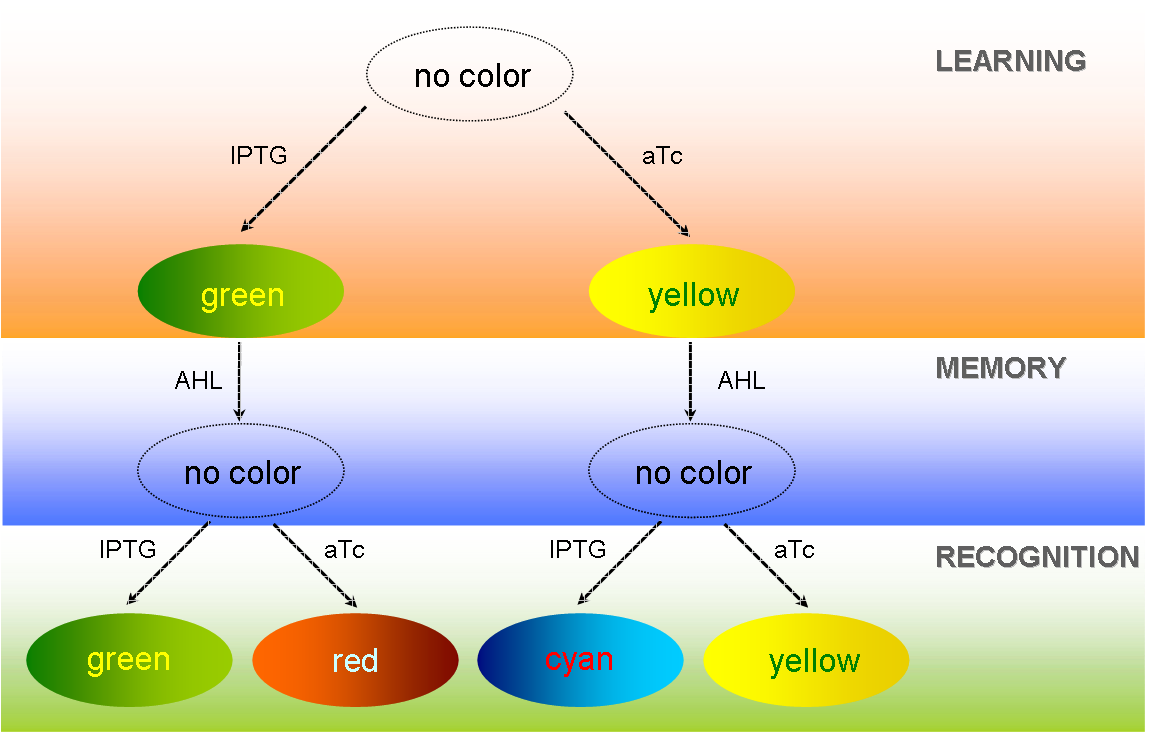
Learning can be considered as a switching of behavior, based on some external stimuli. It comes thus naturally, to work on existing ideas of toggle switches and finite state automatons.
In our system, we are able to distinguish only between two chemicals. The proposed is only a minimal system that should be able to act as a proof of concept. By introducing the ability to have more final states, in an abstract manner, this correlates with the level of "intelligence" of the biological system. A protocol on how the system should react according to an input is shown in Fig. 1.
The idea behind this protocol is that
- The system will be able to learn one of two input signals - aTc or IPTG - during a learning phase if no input signal AHL is present. Depending on the input it will report by producing either green or yellow florescence.
- Once the system has learned, the inputs - aTc or IPTG - can be removed and the system goes into a memory state in the presence of the "helper" substance AHL. In this state no output color is reported. Memorizing is guaranteed by removing the input chemicals. This results in a following successful recognition phase.
- During the recognition phase, the inputs aTc or IPTG are (re-)inserted. The system reports by changing its color depending on the input and its current memory state. This is why the system has different florescent properties even in the presence of the same input. The recognition phase takes place in the presence of AHL to keep the memory enabled and avoid another learning phase. Since we would like to separate four different end states for our system, we had to use four fluorescent proteins to encode them.
.:: Model Overview ::.
One can start developing our system with a top-down approach. We start with the classical back box approach as shown in Fig. 2.
Based on what was discussed in the previous section, the properties that our system has can be summarized as follows:
- We need two inputs that should be learned/detected/adapted to,
- We need one input to switch on the memory.
- We need to alternate between at least three states. That is why we decided to use two state variables - cI and p22cII. -------- ARE YOU SURE ABOUT THAT?
- We need four florescent signals for the outputs. One could also decide to take six output signals into account, to further distinguish the learning phase from the recognition phase. However, we restricted ourselves to 4 outputs to reduce the number of genes that are needed to implement the signals.
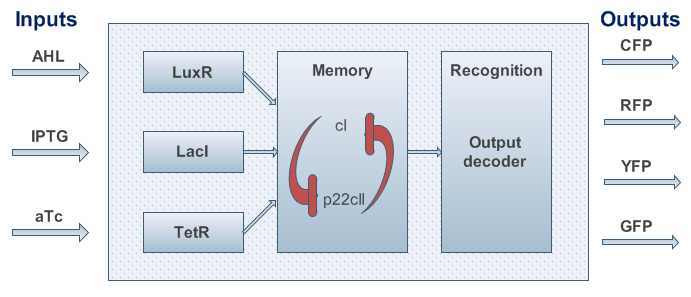
Based on the above, the internal structure of the system can be defined, and it can be seen in Fig. 3. However, we had to keep in mind that the proposed system should be implemented in DNA, and that it would be sensitive to noise. As a result, we took several actions to achieve better experimental results and easier DNA construction:
- To be more robust against perturbations, we coupled the state variables cI and p22cII in the way that is well known from memory circuits. Based on this approach, one state variable is depressing the other one, and the system's internal toggle has the possibility of reaching two stable states.
- Since - due to their size - proteins can only hardly pass the cell membrane (if they are not actively transported through the cell membrane), we decided to use the much smaller inducer molecules AHL, IPTG and aTc as inputs. However, since these inducers cannot directly act on the transcription of the DNA nor on the production of proteins, we need to produce the sensor proteins LuxR, LacI and TetR that build complexes with AHL, IPTG and aTc, respectively.
- The sensor proteins and complexes are used to control the memory formation and the production of the florescent reporter proteins YFP, RFP, CFP and GFP.
.:: Detailed Model ::.
In this section we are transferring our model into a more detailed descriptions of the involved molecules and proteins.
Sensors
As shown in Figure 4, the proteins that act as sensors for the inducer signals are constituitively produced.
Memory
The mechanisms for the memory control are based on the following underlying mechanisms:
- The sensor proteins form complexes together with the inducers. These complexes are used to either activate (in case of the complex consisting of luxR and AHL) or repress (in case of the complexes consisting of LacI and IPTG as well as TetR and aTc) the DNA transciption of the proteins cI and p22cII.
- Futhermore, p22cII and cI repress the DNA transciption of each other.
can be separated into the subsystems shown in Figure 5 and 6.
WE NEED BETTER FIGURE!!! SHOW PATHWAYS FOR LEARNING AND MEMORY (INNER TOGGLE SWITCH)
The final mechanism that is formed is working like this:
- During the learning or training phase there is no cI or p22cII produced so far. If either IPTG or aTc is added, cI or p22cII are produced, respecively. Since no AHL is present the inner toggle switch is turned off.
- During the memory phase AHL is added and the IPTG and aTc are removed. That is why the inner toggle switch is turned off and depending on what is already present either the production of cI or p22cII is continued.
Reporters
Figure 6 gives an overview about the reporter system. Florescence reporter proteins are expressed depending on the inducer concentrations and the concentrations of cI and p22cII. E.g. both the presence of either TetR or cI will repress the production of YFP. However, if the inducer aTc is present aTc will bind to TetR which can no longer block the production of YFP.
Equations
To perform simulations we descibe our system with the help of simple differential equations. We use a simple notation. All concentrations are given in brackets like [cI]. All decay constants are described by a variable d followed by the name of the protein they refer to. We descibe the production of the proteins by a basic constant production level that models the leak of the production system and a factor of l and cmax that descibe the maximum production of a protein given in [M]. Depending on if the DNA for a protein is implemented on a low or a high copy plasmid we distinguish between llo and lhi, respectively.
For a more basic introduction into how to transfer our model into equations see the section Modeling Basics.
Constitutively produced proteins
The equations for the constitutively produced proteins are very simple since we do not have to consider any dependence on other proteins. They are designed so that the protein concentration tends to lhi*cmax/d for steady state.
Allosteric regulation
These equations descibe the formation of complexes between the inducers and sensor proteins. We do not use differential equations but by directly descibing the concentrations of the complexes which is a valid assumption if we alway wait until steady state. We descibe the total amount of proteins by the index 't' while we use the index '*' for proteins that built a complex with the respective inducer. E.g. [TetRt] descibes the total amount of TetR that is available while [TetR*] describes the proteins that are available as a complex with aTc.
Learning system
The learning system is the most complicated part of our system due to the feedback between the state variables and proteins cI and p22cII as well as the variation of the production of these proteins depending on the inputs.
DESCIBE IN MORE DETAIL ONCE THERE ARE THE RIGHT PICTURES
Reporter system
The equations for the reporter system finally descibe the production of the florescence proteins depending on the inputs and memory proteins. Note that both inputs and memory proteins act repressively on the production of the florescence proteins. So e.g. YFP is only produced when there is both no cI and all TetR is bind in a complex together with aTc.
For information regarding how well our system performs have a look at the section Simulations.
A more detailed overview about the parameters that we used to descibe our system is given in the section Parameters.

